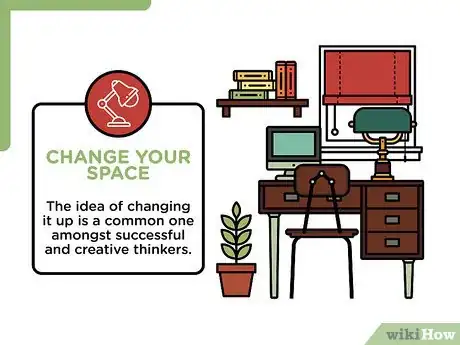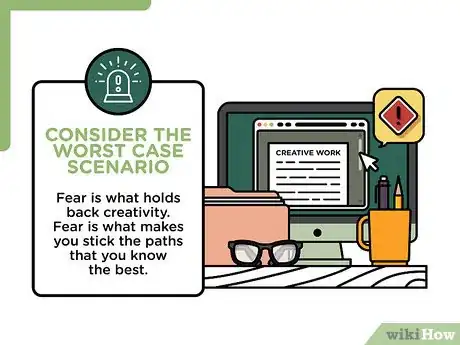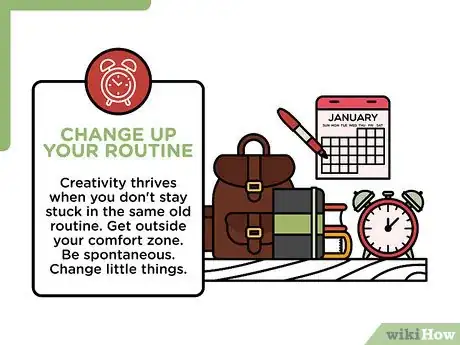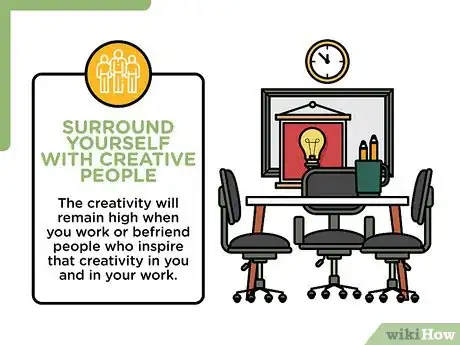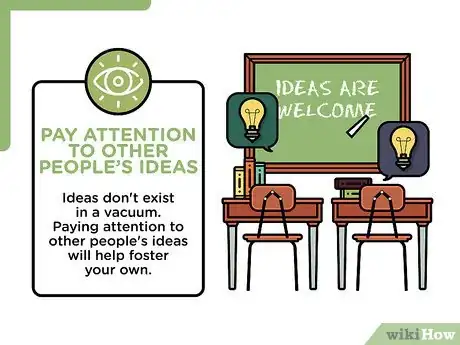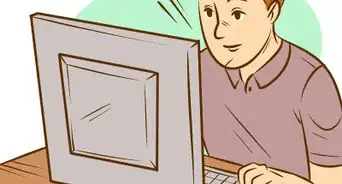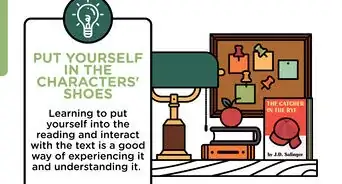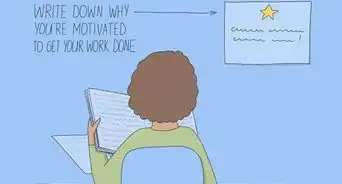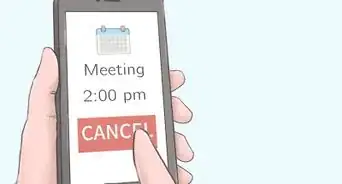This article was co-authored by Mary Church, PhD. Dr. Mary Church is a Licensed Clinical Psychologist based in Honolulu, Hawaii. With over a decade of clinical experience, she aims to integrate evolution, genetics, and neuroscience within the practice of psychotherapy. Dr. Church holds a BS in Psychology from Eckerd College and an MS and PhD in Experimental Psychology from The University of Memphis. She completed a Post-Doctorate in Clinical Psychology at The University of Hawaii at Manoa. In addition, Dr. Church is a member of the American Evaluation Association and Hawaii-Pacific Evaluation Association.
There are 12 references cited in this article, which can be found at the bottom of the page.
wikiHow marks an article as reader-approved once it receives enough positive feedback. This article received 14 testimonials and 96% of readers who voted found it helpful, earning it our reader-approved status.
This article has been viewed 776,404 times.
So you've been asked to think outside of the box for work, or you really want a creative idea for your new novel? Not to worry! Thinking outside the box, like any skill, is one that can be developed through practice. To get started developing your creative thinking skills, see step 1.
Steps
Coming Up with Creative Solutions
-
1Change your space. It's important to get away from all the typical routines in order to foster creativity. The idea of changing it up is a common one amongst successful and creative thinkers. This means that you either create a specific ritual around creativity, or that you simply find a way to take a break.[1]
- Take a shower. There is something weirdly conducive about showering, as anyone who's had that amazing idea while stuck in the shower (only to forget it when you finally locate a pen and paper). If you're stuck on an idea, hop in the shower, with a pen and some paper handy and see what comes up.
- Go for a walk. Like showering, something about walking fosters creativity. Whether it's taking a walk as a prelude to getting started with your creative project, or as part of the project itself, taking a walk will help get those creative juices flowing. Steve Jobs used to hold walking meetings to brainstorm ideas. Tchaikovsky took several walks around his village before working on his latest creation.
- Create psychological distance between your normal routine and the time for creativity. Writer Toni Morrison always watched the sun come up in the morning before she would begin writing. She felt that this enabled her to access her creativity.
-
2Brainstorm. Throwing out tons of different ideas, especially ideas that might seem slightly off-the-wall can be a great idea to pick out a few really good ideas. Brainstorming helps to open up your thinking so that you aren't stuck in the same old thought patterns.
- The brainstorming stage isn't about what is or isn't feasible. Avoid limiting yourself when you're brainstorming. This is the time when all ideas are welcome, no matter how silly or unworkable they sound. If you start limiting yourself during this stage of the thinking game, you aren't going to progress very far.
- Avoid saying things to yourself during this phase that will shut down creativity rather than encourage it. Catch yourself anytime you say: "That won't work," "We haven't done it that way before," "We can't solve this problem," "We don't have enough time."[2]
- For example: say you get stuck while writing your new story. Instead of obsessing over the next stage of the story, start thinking throwing out ideas for what might happen next, or how the story might progress if there were no boundaries on what you could write (even if you needed to change the ending to make the story possible).
Advertisement -
3Re-conceptualize the problem. Part of finding creative solutions and ideas stems from looking at the problem or project in a new way. Looking at something in a new way allows you to look at new possible solutions that you might not otherwise have considered. Fortunately, there are some concrete aids to re-conceptualizing that you can drawn on.[3] [4]
- Turn the problem upside down. This can be done literally or figuratively; turning a picture upside down can actually make it easier to draw, because your brain has to look at it in terms of its makings rather than what it thinks should be there. This works for more conceptual problems.
- For example, if you're writing a book and you can't figure out how to get the protagonist to a certain spot in the story, ask yourself "does this character actually need to be the protagonist? how would the story work with a different character as protagonist? or more than one character?").
- Work backwards. Sometimes what you need is to focus on the solution first, and build backwards from that solution. For example: say you work in the advertising position at a newspaper. The paper is losing money because it hasn't been getting enough ads. Start from the final, best outcome (having lots of the right kind of ads). Work backwards by contacting the types of businesses and groups that can provide the best, most cost-effective ads.
-
4Daydream. Daydreaming helps you to make connections and form patterns and recall information. This is key when you're thinking outside the box, because daydreaming can help you make connections that you might not otherwise have considered. So often your best ideas seem to come out of nowhere while you're daydreaming.[5]
- Give yourself time to daydream. Turn off the computer, t.v., and your phone. If you're constantly plugged into distractions it will be much harder for your brain to rest and make connections.
- You can daydream while on that walk, or in the shower (this is one reason taking time to go for a walk or shower can be so conducive to creative thinking). Daydream in the morning before you have to get up, or at night before you fall asleep.
-
5Set parameters. Sometimes if you're having difficulty thinking outside the box, it's time to give yourself some basic parameters. This may seem like it would hinder creativity, but if you set the right parameters you'll find that it can actually open things up for you.[6]
- Starting too broad can put too much pressure on you. For example: instead of saying "how can I increase ad sales" ask questions like "how can I encourage ad growth from businesses in the community? what can I do to make ads in our paper seem like a good option?" or "how can I target the businesses most likely to place ads in our paper?" or "what compensations can I use to encourage businesses to advertise?"
- You're still asking open questions and still considering a wide variety of options, but you're anchoring your ideas to a specific question or task. This will help you come up with more specific ideas.
- As another example: instead of asking yourself "how can I make my young adult novel different than the others on the market?" you consider more specific parts of the story: "who is the main character? is this main character just like every other main character (white, heterosexual, pretty but doesn't know it?)?" or if it's a fantasy novel "what is the magic system like? is it the vague paganesque, witchy magic that is popping up all over the YA section?"
- Or you could tell yourself that you have to rewrite a scene in your story only now the character doesn't have access to their magic. How are they going to get out of the situation?
-
6Consider the worst case scenario. Fear is what holds back creativity. Fear is what makes you stick the paths that you know the best. When you consider the worst case scenario not only can you plan for it, but you can also convince yourself that the worst case scenario isn't bad enough that you shouldn't try.[7]
- For the ad person example: you might consider what will happen if you try to implement a creative new scheme to offer incentives for long-time advertising partners (like better placement in the layout, a full color ad for a reduced price, etc.). Perhaps the worst that could happen is that no one takes the offer, or that you lose money because of it. Come up with plans for how you might deal with these potential setbacks.
- For the novel-writing example: your worst case scenario might be that no publisher or agent wants to market your novel because what they actually want is a clone of the latest YA bestseller.
Maintaining Your Creativity Long-Term
-
1Eliminate negativity. The thing that will hold you back from thinking outside the box more than anything else is negativity. Consistently telling yourself that you can't think creatively or vetoing every idea as too "out there" is going to severely limit what you come up with.[8]
- Consider what it is that you tell yourself about your ideas. When you come up with that amazing book idea do you immediately think "I could never write that?" That is a surefire what to ensure that you never do write that.
- Whenever you find yourself responding negatively to your ideas, replace the negative thought with a positive or neutral thought. For example: if you found yourself thinking "I'm never going to be able to entice advertisers with these incentives" stop yourself and say "I'm going to test out how these incentives work to get us better advertising faithfulness."
-
2Keep your creativity sharp. Like any skill, creativity needs to be exercised to keep it going. Even when you don't have a particular problem that needs your creative solution, keep working on your creativity. It will help you when you are suddenly confronted with something that needs thinking outside the box.[9]
- Alphabetize words. Take a word from a magazine or a billboard and alphabetize its letters. For example: the word NUMBER would be spelled B-E-M-N-R-U. The reason that this exercise boosts your brain functions is that it forces you to use all the information you're given (all the letters) and do something unusual with them. It trains your brain to come up with surprising connections and solutions and look at problems differently.
- Make a game out of coming up with new or different uses for items in your house. This will teach you to look at items and situations with an eye for the unusual approach. For example: using an old boot as a planter, or building a table out of books.
- If you aren't feeling very creative, try asking questions! Curiosity helps you adopt an open mind, which helps you become more imaginative.[10]
-
3Change up your routine. Creativity thrives when you don't stay stuck in the same old routine. Even the littlest changes can have good consequences for getting you out of a rut and encouraging creative thinking.[11]
- Get outside your comfort zone. Doing new things, especially things you haven't planned for helps you to cope more easily with new situations. It also helps to open your mind and introduce you to new ideas and situations which can help you come up with new or unusual ideas.
- Be spontaneous. Do things that you haven't planned for, occasionally. This will force you to adapt to the moment and overcome problems on the fly. You could even tie this in with an ongoing project.
- Change little things. For example: walk home from work a different way each day. Change up which coffee shop you go to in the mornings.
-
4Study another industry. This will help to show you how people outside your chosen field operate and give you ideas you can incorporate into your field. The industry could be completely different from yours, or have some overlap, but it should be different enough to give you a fresh perspective on your own.
- For example: the ad person might take a look at psychology topics or look into how the businesses they're asking for ads from operate.
- The novelist might read outside their chosen field (YA) looking at nonfiction, mysteries, and the classics for inspiration.
-
5Learn new things. The more you broaden your horizons the more connections your brain is going to be able to make. The more information your brain has access to, the more it's able to come up with unusual ideas.[12]
- Take classes outside of your field. This could be anything from cooking classes (provided you aren't a chef) or rock climbing. The novelist might then use what she learned in their cooking class to come up with a system of magic (the people who have a feel for what they're doing and don't use instructions as opposed to those who carefully follow a specific set of instructions).
- Learn a new language. Not only does this help keep your mind sharp and forming new connections, it can open you up to new ways of thinking. The ad person might use it to start a section of bilingual ads that reach to a different group of people than she had normally been targeting.
Connecting With Other People Creatively
-
1Surround yourself with creative people. Humans are social animals. You'll be inspired when other people are inspired. The creativity will remain high when you work or befriend people who inspire that creativity in you and in your work.
- You find it especially helpful if you befriend people who aren't in the same field that you are. These people can give you perspective on your work that you wouldn't get from someone who is saturated in the same ideas that you are.
- This is another reason why it's so important to do things outside of your comfort zone. That is where you'll meet people who challenge and inspire creativity in you, people who think differently from you.
-
2Pay attention to other people’s ideas. Ideas don't exist in a vacuum. Even creative thinkers like Salvador Dali (as an example) started with ideas in his painting that he'd gotten from earlier sources. Paying attention to other people's ideas will help foster your own.
- You’ll see how other people think outside the box. Learning other people's thought patterns and ways of thinking will help you keep from stagnating in your own thinking. You could even say to yourself "How might my creative painter friend view this problem of ads?"
- You can also look at the ideas of famous innovators. Examine what ideas they had that worked and what ideas didn't work. Look at their practices for encouraging creative thinking (like the examples of Steve Jobs, Tchaikovsky, and Toni Morrison in the first part of the article) and try those practices out.
- Try to approach other people's ideas with curiosity instead of judgment.[13]
-
3Learn to listen. One way to encourage creative thinking is to stay quiet and listen to what other people are saying. Part of why this is such a good idea is that it helps you really hear what other people are saying so you don't present the same ideas that have already been presented. It also helps you to marshal your thoughts before you speak.
- For example: the ad person tried to sell ads to a business that really hated the newspaper. If they hadn't really listened to the concerns of the business (like they felt their ads weren't given priority, and they didn't like some of the content in the newspaper), they wouldn't have gotten the business to place an ad. This business then became part of their scheme to bring other unsatisfied advertisers back into the fold.
-
4Remember, you will be presenting ideas that might be outside of "normal." This is just something to remember when you're engaging with other people, especially in terms of business relations. Sometimes the ideas from outside of the box aren't actually the right way to go.
- It's also good to keep in mind that your ideas aren't always going to work. That's okay! It's a part of the learning process and it's why you consider the worst case scenario when you're coming up with an idea.
Warnings
- Learning to change your style of thinking is not an easy process, or a quick one. Be patient. Enjoy the journey.⧼thumbs_response⧽
References
- ↑ http://www.huffingtonpost.com/2014/07/17/how-to-find-great-ideas_n_5591342.html
- ↑ http://www.umich.edu/~elements/probsolv/strategy/brainstorming.htm
- ↑ http://www.entrepreneur.com/blog/224501
- ↑ http://blogs.hbr.org/2011/11/how-to-think-creatively/
- ↑ https://behavioralscientist.org/daydreaming-might-make-you-more-creative-but-it-depends-on-what-you-daydream-about/
- ↑ http://www.entrepreneur.com/article/224807
- ↑ https://hbr.org/2020/09/what-to-do-when-your-mind-always-dwells-on-the-worst-case-scenario
- ↑ https://www.psychologytoday.com/intl/blog/click-here-happiness/202101/8-science-based-ways-beat-negativity
- ↑ http://www.psychologytoday.com/blog/the-power-forgetting/201404/surprising-exercises-get-you-thinking-outside-the-box
- ↑ Mary Church, PhD. Research & Clinical Psychologist. Expert Interview. 6 August 2021.
- ↑ http://www.umich.edu/~elements/probsolv/strategy/creative.htm
- ↑ https://www.psychologytoday.com/us/blog/science-choice/201912/9-key-principles-learning-new-skill
- ↑ Mary Church, PhD. Research & Clinical Psychologist. Expert Interview. 6 August 2021.
About This Article
To think outside of the box, try to learn new things and pick up new skills as much as possible, which will broaden your horizons and help you think of unique and unusual ideas. Also, exercise your creativity by doing fun, creative projects at home that require you to be resourceful. Even just changing up your daily routine by doing things like taking a different route to work or grabbing breakfast from a new coffee shop can spark your creativity and help you think of a new way to approach an issue. To learn how to come up with creative solutions to problems, keep reading!
